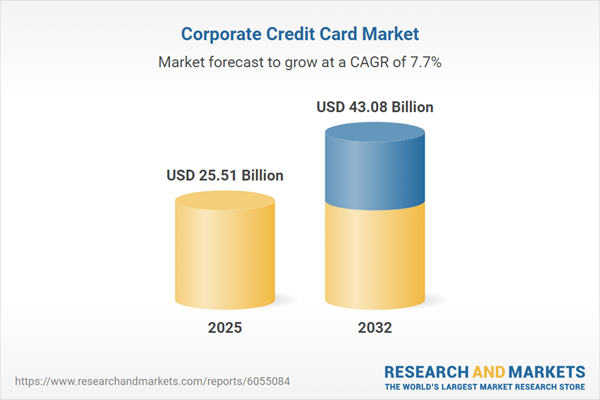Speak directly to the analyst to clarify any post sales queries you may have.
The corporate credit card market is transforming the way large and mid-sized organizations manage spend, integrate compliance, and enhance financial control. Modern corporate card strategies and technology adoption are driving improvements in operational efficiency, risk management, and agility for senior financial decision-makers.
Market Snapshot: Robust Growth and Evolving Corporate Payment Dynamics
The corporate credit card market grew from USD 23.78 billion in 2024 to USD 25.51 billion in 2025 and is projected to reach USD 43.08 billion by 2032, expanding at a CAGR of 7.71%. This sustained growth highlights increasing adoption rates as organizations seek more transparent, secure, and scalable solutions for business-to-business payment processes and expense controls.
Scope & Segmentation: Multi-Layered Insights Across Stakeholder Needs and Geographies
- Card Types: Charge cards, prepaid corporate credit cards, standard corporate credit cards, travel corporate credit cards, virtual corporate credit cards.
- Expenditure Limits: High limit, low limit, medium limit configurations tailored for various purchasing roles and department structures.
- Renewal Flexibility: Annual renewal and bi-annual renewal options to suit diverse budgeting and policy cycles.
- Application Scenarios: Business travel (including car rentals, flights, hotels), employee benefits (such as meal cards, transport allowance, wellness programs), procurement (spanning facility management, office supplies, technology purchases).
- End-Users: Solutions are designed for large enterprises, medium enterprises, and small enterprises with varying administrative and integration requirements.
- Regional Coverage: Americas (North and Latin America), Europe (including Middle East and Africa), and Asia-Pacific, each reflecting unique regulatory and technology environments.
- Company Analysis: Coverage includes leading industry players such as American Express Company, Bank of America Corporation, Citigroup Inc., Visa Inc., JPMorgan Chase & Co., Deutsche Bank AG, and others across major financial regions.
Key Takeaways: Strategic Insights for Senior Decision-Makers
- Technological advancements, including AI-driven analytics and integrated expense management tools, are streamlining workflows and enabling real-time compliance and reporting.
- Regulatory development and sustainability initiatives are prompting companies to implement diverse cost-tracking, carbon offset, and supplier diversity measures in their expense policies.
- Virtual card solutions and mobile-first applications are mitigating fraud risks and supporting rapid, policy-compliant payments across multiple business units and regions.
- Corporate credit card programs are adapting to departmental requirements by providing customizable spending limits and renewal cycles, contributing to greater policy flexibility.
- Platform interoperability and modular API suites allow organizations to integrate card management with procurement and ERP systems, enhancing visibility and user experience.
Tariff Impact: Navigating Procurement Costs and U.S. Cross-Border Transactions
The implementation of 2025 United States tariffs is placing pressure on global procurement and expense management strategies. Organizations dependent on international supply chains are reassessing contracts, exploring new sourcing partners, and leveraging dynamic fee alerts and currency conversion features to optimize settlement and working capital. These market changes make adaptive, analytics-driven card programs increasingly vital for cost control and operational continuity.
Methodology & Data Sources
This report integrates extensive secondary research—drawing from financial statements, regulatory documents, and proprietary datasets—with primary interviews and quantitative surveys of finance, procurement, and technology leaders. Data validation includes triangulation and advanced statistical analysis, overseen by industry advisory panels to ensure insight reliability and actionable relevance.
Why This Report Matters
- Enables informed strategic planning by clarifying how emerging technology, regulatory change, and procurement trends are reshaping the corporate credit card landscape.
- Empowers finance and operations leaders to benchmark current expense structures, mitigate regulatory risk, and align program features with organizational goals.
- Delivers detailed segmentation and practical recommendations to support targeted solution design and investment decisions in diverse geographies.
Conclusion
Senior leaders seeking to optimize operational agility and governance will find this research offers a comprehensive foundation for corporate credit card program enhancement and risk management. The findings empower forward-looking organizations to design flexible, tech-enabled expense management strategies for sustainable growth.
Table of Contents
3. Executive Summary
4. Market Overview
7. Cumulative Impact of Artificial Intelligence 2025
Companies Mentioned
The companies profiled in this Corporate Credit Card market report include:- American Express Company
- AU Small Finance Bank Limited
- Bank of America Corporation
- Barclays Bank PLC
- BNP Paribas
- Capital One Financial Corporation
- Citigroup Inc.
- Deutsche Bank AG
- DFS Services LLC
- First Abu Dhabi Bank
- HSBC Holdings PLC
- ICICI Bank Limited
- ING Bank N.V.
- Intesa Sanpaolo Bank
- JPMorgan Chase & Co.
- Lloyds Bank PLC
- MasterCard Incorporated
- Mitsubishi UFJ Financial Group
- Nordea Bank
- PNC Financial Services Group, Inc.
- Royal Bank of Canada
- Santander Bank
- Scotiabank
- Standard Chartered PLC
- Synchrony Bank
- TD Bank
- The Goldman Sachs Group, Inc.
- U.S. Bancorp
- UBS Group AG
- Visa Inc.
- Wells Fargo & Company
Table Information
| Report Attribute | Details |
|---|---|
| No. of Pages | 186 |
| Published | November 2025 |
| Forecast Period | 2025 - 2032 |
| Estimated Market Value ( USD | $ 25.51 Billion |
| Forecasted Market Value ( USD | $ 43.08 Billion |
| Compound Annual Growth Rate | 7.7% |
| Regions Covered | Global |
| No. of Companies Mentioned | 32 |









